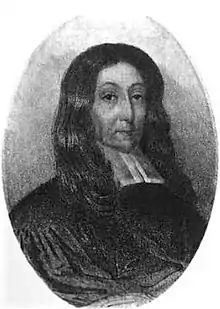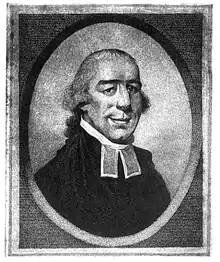First Church in Boston
First Church in Boston is a Unitarian Universalist Church (originally Congregationalist) founded in 1630 by John Winthrop's original Puritan settlement in Boston, Massachusetts. The current building is on 66 Marlborough Street in Boston. The church has long been associated with Harvard University.

History
The church was created in 1630 when the settlers on the Arbella arrived in what is now Charlestown, Massachusetts.[1] John Wilson was the first minister, and the only minister while the church was in Charlestown. Two years later they constructed a meeting house across the Charles River near what is now State Street in Boston, and Wilson was officially installed as minister there. In 1633 John Cotton arrived from England, and was a teaching elder at the church, helping to establish the foundation of the Congregational Church, the official state church of Massachusetts. In 1677 Dorcas ye blackmore, a freed slave, was allowed to become the first African American member of the church. [2] In the 18th century, Charles Chauncy was a minister at First Church for sixty years[3] and gained a reputation for opposing what he believed was emotionalism during the Great Awakening of Jonathan Edwards.[4]
A schism developed at the turn of the 19th century, the trinitarian Christian church eventually transformed into a unitarian congregation by the mid-19th century along with many of the other state churches in Massachusetts.[5] Massachusetts' state churches (largely Unitarian and Congregationalist) including First Church were officially disaffiliated with the government in 1833.
In the 19th century, the First Church moved to Back Bay in Boston. The building at 66 Marlborough Street in Boston dated from 1867 and was designed by Boston architects William Robert Ware and Henry Van Brunt. After a fire in 1968, First Church and Second Church merged and built a new building at the same location. This building, by architect Paul Rudolph, incorporates part of the facade of the 1867 building.
Second Church, founded in 1649 when the population spread to the North End legitimated an additional congregation sited closer to those individuals' homes, was also known as the "Church of the Mathers;" its pulpit was home to Increase Mather, Cotton Mather, and Samuel Mather from 1664 to 1741. Both churches were examples of the westward movement of Boston churches from the crowded, older downtown area to the newer, more fashionable Back Bay after it was filled in during the late 19th and early 20th centuries. Second Church's Back Bay location in the Fenway was sold (it is now owned by the Ruggles St. Baptist congregation) just before the merger.[6]
Notable people associated with the church
- John Wilson (pastor 1632–1667; died 1667)
 First Church in 2008
First Church in 2008 - John Cotton (pastor 1633–1652)
- John Winthrop, founder and governor of Massachusetts Bay Colony
- John Norton (pastor 1656–1663)
- John Davenport (pastor 1668–1670)
- James Allen (pastor 1668–1710; died 1710)
- John Oxenbridge (pastor 1670–1674)
- Joshua Moodey (pastor 1684–1692; died 1697)
- John Bailey (pastor 1693–1697; died 1697)
- Benjamin Wadsworth (pastor 1696–1737)
- Thomas Bridge (pastor 1705–1715; died 1715)
- Thomas Foxcroft (pastor 1717–1769)
- Charles Chauncy (pastor 1727–1787)
- John Clarke (pastor 1778–1798)
- William Emerson (pastor 1799–1811)
- John Lovejoy Abbot (pastor 1813–1814)
- Nathaniel Langdon Frothingham (minister 1815–1850)
- Sophia Henrietta Emma Hewitt (music director 1815–17(?), daughter of James Hewitt
- Charles Zeuner (music director 1839–?)
- Lucien H Southard (music director 1848–?)
- Rufus Ellis (pastor 1853–c. 1885; died 1885)[7]
- Whitney Eugene Thayer (music director 1869–1875)
- Arthur Foote (music director 1878–1910)
- Charles Edwards Park (minister 1906–1946, emeritus 1946–1962)
- Rhys Williams (minister 1960–2000)
- Stephen Kendrick (minister 2001–present)
- Paul Cienniwa (music director 2006–2017)
Image gallery
State St. (1632–1639)
 First meeting house, built 1632
First meeting house, built 1632 John Wilson (pastor 1632–1667)
John Wilson (pastor 1632–1667) John Cotton (pastor 1633–1652)
John Cotton (pastor 1633–1652)
Washington St. (1639–1808)
 Location near Old State House, 17th century
Location near Old State House, 17th century John Davenport (pastor 1668–1670)
John Davenport (pastor 1668–1670) Old Brick Church, Washington St., built 1713
Old Brick Church, Washington St., built 1713 John Clarke (pastor 1778–1798)
John Clarke (pastor 1778–1798)
Chauncy Place (1808–1867)
 William Emerson (pastor 1799–1811)
William Emerson (pastor 1799–1811) Chauncy Place, 1808–1867
Chauncy Place, 1808–1867 Chauncy Place, 1808–1867
Chauncy Place, 1808–1867 Nathaniel Langdon Frothingham (pastor 1815–1850)
Nathaniel Langdon Frothingham (pastor 1815–1850)
Marlborough St. (1868–present)
 19th century
19th century Rufus Ellis (pastor 1853 – c. 1885)
Rufus Ellis (pastor 1853 – c. 1885) Marlborough St. and Berkeley St., 1920
Marlborough St. and Berkeley St., 1920
References
- Arthur Blake Ellis; George Edward Ellis (1881). History of the First Church in Boston, 1630–1880. Boston: Hall and Whiting.
- Deborah Colleen McNally, "To Secure her Freedom: “Dorcas ye blackmore,” Race, Redemption, and the Dorchester First Church" The New England Quarterly, Volume 89 | Issue 4 | December 2016 , p.533-555
- Ellis and Ellis (1881), p. 191.
- Ellis and Ellis (1881), pp. 202–203.
- Paul Erasmus Lauer, Church and State in New England (Johns Hopkins Press, 1892), pp. 105–107. (accessed September 20, 2009)
- See Second Church records.
- "Boston Pulpit". Gleasons Pictorial. Boston, Mass. 5. 1853.
Further reading
- Leo W. Collins. This Is Our Church: The Seven Societies of the First Church in Boston 1630–2005. Boston: Society of the First Church in Boston, 2005. Google books
- Paul Rudolph & his architecture. A page from a website devoted to Rudolph's work, featuring photos of the church building. Paul Rudolph & his architecture
External links
| Wikimedia Commons has media related to First Church in Boston. |